Can you imagine your smartphone or laptop screen displayed directly through your contact lens? The possibilities are endless. Imagine being lost in the city and needing directions. Easy! A map overlay appears in your visual field. Or sitting bored in a reception room—flip through a book or watch your favorite movie. Better yet, maybe you don’t have to come into the doctor’s office at all because your practitioner can remotely monitor your condition using biometric sensors in the lens. The truth is that this reality—once strictly the domain of science fiction—is not too far away.
As with any cutting-edge technology, smart contact lens research has advanced markedly even just since last year’s preview of projects in the pipeline (“The Future is Now: Unveiling Smart Contact Lenses,” May 2011).1 New technology reports, published patent applications and clinical trial data presentations indicate an emerging megatrend in consumer electronics that is forecasted to impact millions.
Industry leaders propose a tantalizing future: Contact lenses will ultimately be the preferred display console for wearable computers, offering a seamless merging of the physical and the digital worlds (so-called augmented reality, or AR). At the same time, these technologies also will be applied to medical monitoring, telemedicine, low vision, and defense and security.
Industry Predictions
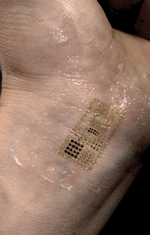
1. Wearable electronic sensor for heart activity will communicate with a contact lens-enabled wearable display. (Photo: John Rogers, Ph.D.)
The defining milestone in the evolution of smart lenses was the success in incorporating passive and active components directly within contact lenses, rather than as external components; it was never going to be practical to expect users to wear an external battery pack or recording device. This breakthrough was made possible in part by the phenomena of Bell’s Law and nanotechnology. Bell’s Law is a function of the 100 times reduction in size of electronics every 10 years.2 Mainframe computers, once enormous, are now reduced to the size of the head of a pin.
A number of technologists are developing sensors, processors, power sources, wireless antenna and other microelectromechanical systems (MEMS) that are small enough to be placed in contact lenses. The added challenges of making the components biocompatible, able to be sterilized, low cost and robust in a hydrated substrate are also being addressed.
A telltale indicator of the future can be found in the public comments of a number of thought leaders and decision makers in information technology, video gaming and telecommunications. Michael Abrash, a Microsoft veteran and major contributor at Valve, a very forward-thinking video game company, said, “The logical endpoint is computing everywhere, all the time—that is, wearable computing.” In outlining a possible technological timeline, Mr. Abrash said that in 20 years, wearable computing will be the industry standard—but he expects to see the technology make a mainstream appearance within 10 years, and as soon as in three to five years. “The key areas (input, processing/power/size and output) need to evolve to enable wearable computing are shaping up nicely, although there’s a lot still to be figured out,” he said.3
Recent patent approvals seem to confirm Mr. Abrash’s prediction.4 Canon, for example, has 58 U.S. patents covering head-mounted displays (HD) and augmented reality (AR) technologies, while Microsoft and IBM each have 53 HD and 41 AR patents to add to their growing U.S. portfolios.
Google has earned 36 U.S. patents, with another four pending applications related to this technology. Ten of the issued patents claim designs for eyewear, while the remaining 26 relate to the technology for eye tracking, eye-based cursor movement and content selection, as well as content modulation that incorporates hand, finger and head movements. In an interview about the project, Steve Lee of Google said, “Smartphone-like contacts are the next natural step in the process.”5 Valve’s co-founder, Gabe Newell agreed.6
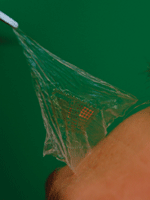
2. Removing an electronic sensor for measuring brain activity. (Photo: John Rogers, Ph.D.)
Google’s trailblazing, spectacle lens enabled Project Glass will even make wearable computer “eyeware” a fashion statement by walking the runway at the Diane Von Furstenberg show in 2013.7 Google Glass is a lighter form, more similar to conventional eyewear when compared to early images of the Microsoft Kinect 2 or the Oculus Rift products.8,9
Clinical Applications
Is AR technology simply a means of staying connected in an increasingly digital world, or does it offer potential clinical benefits as well? Several technology teams are working on methods of measuring IOP and blood sugar through contact lenses, including the Triggerfish lens from the MEMS technology leader Sensimed.10-12 Clinical trial data were recently reported for IOP-monitoring contact lenses; the study concluded that repeated use of the contact lens sensor demonstrated good safety and tolerability. The recorded IOP patterns showed fair to good reproducibility, which suggests that data from continuous 24-hour IOP monitoring may be useful in the management of patients with glaucoma.13
Microsoft and the University of Washington conducted an animal study on the use of a contact lens to sense blood sugar levels; no corneal damage was found on the tested rabbits.14
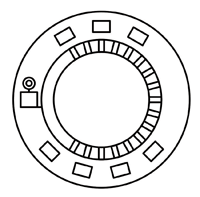
3. Refractive therapy contact lens with programmable light sources.
Other teams are developing wearable sensors for EEG, EKG, blood pressure, pulse and other body functioning monitors (figures 1 and 2).15 Currently under development is an array of wearable sensors which can communicate to monitors that can also be worn. The practicality of this technology is threefold: Patients can closely monitor their own bodies and have access to direct quantitative data; sensors can directly communicate with practitioners or healthcare systems; and, ultimately, the sensors may communicate to wearable pumps or electrostimulus systems that deliver pharmaceuticals or stimuli, with monitoring by the patient or the practitioner through the cloud. This research is being led by John Rogers, Ph.D., and colleagues at Northwestern University and the University of Illinois at Urbana-Champaign.15
Measurement is the first step to modulation. The internal eye and the tear film provide other valuable systemic information. It is anticipated that sensors in a contact lens can measure blood alcohol level and tear film components, including inflammatory mediators. These sensors could provide warnings to the wearer and could drive release of anti-inflammatory or other ocular surface therapeutic agents to modulate ocular surface health and comfort.
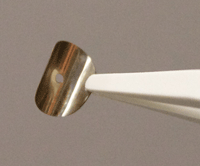
4. Gas-permeable nanopolarizer for iOptik contact lens.
Therapeutic Devices
Treatment of seasonal affective disorder (SAD) using external light sources that attempt to reset the patient’s circadian rhythms have been of limited benefit because it currently requires patients to sit in front of a light box each day for lengthy periods of time. The field could be revolutionized by research currently underway to use contact lenses with light-emitting diodes in a prescribed wavelength to stimulate the pineal gland through the non-image retinal pathway. The resultant modulation of seratonin would help control one’s mood, without the tedium of using a light box. This potentially groundbreaking science is being investigated by researchers in Jacksonville, Fla.; the team has recently published several patent applications on these lenses.16
Preventive Science, Inc., has similar technology for the regulation of refractive error with an emphasis on the prevention of myopia.17 Known as “eyewear-borne electromagnetic radiation,” this technology incorporates light sources in contact lenses to provide a prescribed wavelength, direction, retinal area, illumination level and duration for the regulation of refractive error (figure 3). Recent publications point to the role of near visible ultraviolet light, as well as the role of outdoor light exposure in animal models and humans, to support the future use of contact lenses with illumination sources for refractive therapy.18-21
Drug Delivery
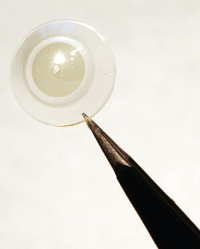
5. Passive optics iOptik mini-scleral lens on NormalEyes 15.5 platform to enable a “wearable computer.”
The most visible breakthrough in drug delivery smart lenses is the reported success in sustained drug delivery with imprinted drug-eluting contact lenses, from graduate student Arianna Tieppo and colleagues at Auburn University.22 In addition, tests on the slow release of antibiotics with fibrin-coated lenses showed mix results. The lenses loaded with gentamicin performed better than those soaked in gentamicin, however the results varied with other antibiotics, according to Ph.D. student Alex Hyatt and colleagues at University of Cambridge.23
Other advances in this field include the use of a sandwiched layer of PLGA (poly-lactic-co-glycolic acid), a biodegradable polymer to regulate the amount of pharmaceutical that passes through the lens over time, by researchers at Boston Children’s Hospital.25
Restoring and Enhancing Vision
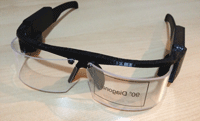
6. iOptik off axis projection with transflective diffuser 90° field eyewear model.
On The Six Million Dollar Man, Steve Austin’s “bionic” eye provided image magnification and enhancement that proved vital to his missions. On Star Trek: The Next Generation, Geordi LaForge’s visor restored vision lost to blindness. One day, low vision patients and soldiers might achieve something akin to these fictional breakthroughs in a wearable, removable contact lens, without need for prosthetics or implants.
The Innovega iOptik contact lens technology features the first gas-permeable polarizer component that can be incorporated in rigid and hydrogel substrates. Polarization is one means of separating the display optical path from the optical path for the normal real world visual content (figure 4). The first clinical trials, conducted at the Naval Medical Center San Diego, demonstrated high-contrast photopic and low-contrast mesopic visual acuity equivalent to best spectacle-corrected baseline measures while demonstrating display visual acuity at the highest resolution that the display could present (0.2 logMAR, 20/32).26
The first generation iOptik contact lens is expected to use the NormalEyes 15.5 (Paragon Vision Sciences) mini-scleral lens (figure 5). This smart lens system is forecast to provide help for low vision patients by the delivery of electronic image amplification and image presentation. This hands-free, full field of view software-modulated system will allow more magnified content to be seen than previously visible with spectacle-mounted conventional telescopes, microscopic systems or closed-circuit electronic display systems.
The eyewear will use lightweight lenses that incorporate a transflective diffuser to reflect red, green and blue laser-generated images from a small pico projector mounted in the temple of the frame. The first-generation system is engineered to provide 720p resolution over a 90º field (figure 6).
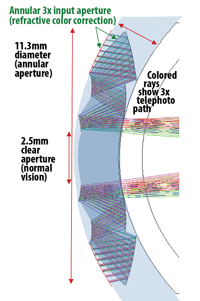
7. Hands-free zoom telescopic contact lens ray tracing. (Photo: Photonic Systems Laboratory, UCSD)
For soldiers, a lens that will provide full-field imaging of an eyewear display and a hands-free zoom telescopic function is currently under development under the Defense Advanced Research Projects Agency program, SCENICC (soldier centric imaging via computational cameras). The telescopic function of the lens is provided by folded reflective optics, which collapses the telescopic path to a thickness that can be incorporated into a contact lens (figure 7).
This is the first wearable scleral lens with folded optics, which delivers a 3X telescopic path and a normal 1X path. The lenses will incorporate polarizers to allow switching from the normal 1X path to the telescopic path as needed. The hands-free zoom lens is forecast to add to the prescription armament for low vision patients in addition to the defense application. A primary advantage of the system is the high levels of light transmission of the telescopic path due to the image gathering in an annulus, which is located outside the pupil. Novel systems for oxygen transmission are included in the lens (figure 8).
This entire project is spearheaded by University of California San Diego, in conjunction with Innovega and a number of technology companies. The lens was developed by Paragon Vision Sciences. The optics and patented technology were designed by Joseph Ford, Ph.D., and colleagues at the Photonics Systems Integration Laboratory at UCSD.27
Smart contact lens technology is coming, and it is well thought out. Even so, these products will present new regulatory questions and require new medical device roadmaps. Some will be easier and faster to commercialize than others. It is anticipated that passive systems will reach the market with the shortest regulatory time, although active systems like the MEMS-containing Triggerfish have pioneered the way for others to follow.
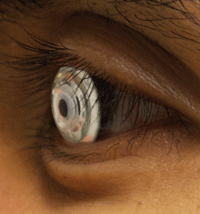
8. Hands-free zoom (1x to 3x) telescopic contact lens without cosmetic layer.
We can anticipate that there will be ethical issues and concerns about visual performance. Just as eye care professionals and technologists have directed attention to the safety, efficacy and human impact of 3D television and 3D game-playing, how smart lenses will affect humans needs to be better understood. Vision is a dominant sensory process and integrates dynamically with the rest of the human central and autonomic nervous system. One of the first ethical questions to address will be the safety concerns when driving while wearing these media rich lenses.
At the same time, we may likely face privacy issues because wearable computers, linked to the cloud, will be equipped with face recognition capacity. We may ultimately find that the smart lenses may be too smart.
Dr. Legerton is an author, lecturer, inventor and consultant to the ophthalmic industry. He is a cofounder of SynergEyes and Innovega, and has 33 issued U.S. patents for contact lens technology including Synerg-Eyes, Paragon CRT, myopia progression control, presbyopic laser refractive surgery, and novel multifocal contact lenses. A recent patent is assigned to Innovega for the iOptik contact lens enabled wearable computer.
Dr. Legerton has direct financial interest in Innovega and Preventive Science, and is a consultant to Paragon Vision Sciences.
1. Legerton J. The future is now: unveiling smart lenses. Rev Cornea Contact Lens. 2011 May;147(4):17-20.
2. Bell G. Bell’s law for the birth and death of computer classes. Communications of the ACM. 2008 Jan;51(1):86-94.
3. Abrash M. Valve: how I got here, what it’s like, and what I’m doing. Ramblings in Valve Time. 2012 Apr 13. Available at: http://blogs.valvesoftware.com/abrash/valve-how-i-got-here-what-its-like-and-what-im-doing-2. Accessed September 2012.
4. Gannes L. Peering into the patent portfolio behind Google Glass. All Things D. 2012 Sep 15. Available at:
http://allthingsd.com/20120915/peering-into-the-patent-portfolio-behind-google-glass. Accessed September 2012.
5. Newman J. Google Project Glass: contact lenses a ‘long-term thing.’ Time Techland. 2012 May 31. Available at:
http://techland.time.com/2012/05/31/google-project-glass-contact-lenses-a-long-term-thing/#ixzz26RlcDxzq. Accessed September 2012.
6. Duryee T. Valve’s Gabe Newell on the future of games, wearable computers, Windows 8 and more. All Things D. 2012 Jul 25. Available at:
http://allthingsd.com/20120725/valves-gabe-newell-on-the-future-of-games-wearable-computers-windows-8-and-more/?mod=mailchimp. Accessed September 2012.
7. Gorman M. Google Glass shows how Diane von Furstenberg is living, what it’s like at New York Fashion Week. Endgadget. 2012 Sep 14. Available at:
www.engadget.com/2012/09/14/google-glass-diane-von-furstenberg-new-york-fashion-week-video. Accessed September 2012.
8. Benedetti W. Xbox leak reveals Kinect 2, augmented reality glass. NBC News. 2012 Jun. Available at:
www.nbcnews.com/technology/ingame/xbox-leak-reveals-kinect-2-augmented-reality-glasses-833583. Accessed September 2012.
9. Oculus. 2012. Available at: http://oculusvr.com. Accessed September 2012.
10. Newsome M. High tech contact lenses monitor blood sugar. Healthymagination. 2010 Nov. Available at:
www.healthymagination.com/blog/high-tech-contact-lenses-monitor-blood-sugar. Accessed September 2012.
11. Eng P. Color-change lenses check blood sugar. ABC News. 2010 Apr. Available at:
www.abcnews.go.com/Technology/FutureTech/story?id=97664&page=1. Accessed September 2012.
12. Smart contact lenses. UC Davis. 2008 Jul 30. Available at:
www.news.ucdavis.edu/search/news_detail.lasso?id=8722. Accessed September 2012.
13. Mansouri K, Medeiros FA, Tafreshi A, Weinreb RN. Continuous 24-hour monitoring of intraocular pressure patterns with a contact lens sensor: safety, tolerability, and reproducibility in patients with glaucoma. Arch Ophthalmol. 2012 Aug 13. [Epub ahead of print]
14. Mick J. Contact lens capable of displaying text and images is almost at hand. Daily Tech. 2011 Nov 23. Available at:
www.dailytech.com/Contact+Lens+Capable+of+Displaying+Text+and+Images+is+Almost+at+Hand/article23353.htm. Accessed September 2012.
15. Ma R, Kim DH, McCormick M, et al. A stretchable electrode array for non-invasive, skin-mounted measurement of electrocardiography (ECG), electromyography (EMG) and electroencephalography (EEG). Conf Proc IEEE Eng Med Biol Soc. 2010;2010:6405-8.
16. Pugh R. Light therapy system including spectacle frames and contact lenses. US Patent Trademark Office. 2012 Aug 23. Available at:
http://appft1.uspto.gov/netacgi/nph-Parser?Sect1=PTO2&Sect2=HITOFF&p=1&u=%2Fnetahtml%2FPTO%2Fsearch-bool.html&r=2&f=G&l=50&co1=AND&d=PG01&s1=pugh.IN.&OS=IN/pugh&RS=IN/pugh. Accessed September 2012.
17. Legerton J. New innovations and the future of corneal reshaping and refractive therapy. Presentation at the Vision by Design annual meeting, April 20, 2012; Scottsdale, Ariz.
18. Jones LA. Parental history of myopia, sports and outdoor activities, and future myopia. Invest Ophthalmol Vis Sci. 2007 Aug;48(8):3524-32.
19. Smith E. Protective effects of high ambient lighting on the development of form-deprivation myopia in rhesus monkeys. Invest Ophthalmol Vis Sci. 2012 Jan;53(1):421-8.
20. Siegwart JT, Ward AH, Norton TT. Moderately elevated fluorescent light levels slow form deprivation and minus lens-induced myopia development in tree shrews. Paper presented at the Association for Research in Vision and Ophthalmology annual meeting, May 8, 2012: Fort Lauderale, Fla.
21. Sherwin JC. The association between time spent outdoors and myopia using a novel biomarker of outdoor light exposure. Invest Ophthalmol Vis Sci. 2012 Jul 1;53(8):4363-70.
22. Tieppo A, White CJ, Paine AC, et al. Sustained in vivo release from imprinted therapeutic contact lenses. J Control Release. 2012 Feb 10;157(3):391-7.
23. Hyatt AJ, Rajan MS, Burling K, et al. Release of vancomycin and gentamicin from a contact lens versus a fibrin coating applied to a contact lens. Invest Ophthalmol Vis Sci. 2012 Apr 18;53(4):1946-52
24. Epstein A. Technological advances in drug delivery. Rev Cornea Contact Lens. 2012 May;149(4):29-31.
25. Ciolino JB, Hoare TR, Iwata NG, et al. A drug-eluting contact lens. Invest Ophthalmol Vis Sci. 2009 Jan 10;50(7):3346-52.
26. Unpublished data. Innovega.
27. Tremblay EJ, Beer RD, Arianpour A, Ford JE. Telescopic vision contact lens. SPIE Digital Library. 2011 Feb;7885:788510.


